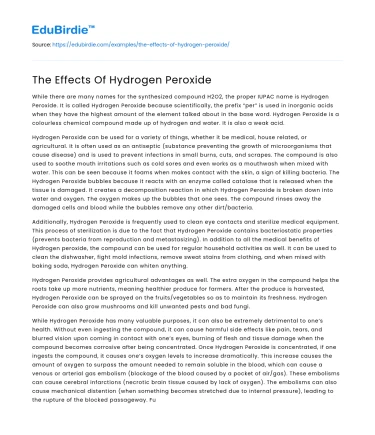While there are many names for the synthesized compound H2O2, the proper IUPAC name is Hydrogen Peroxide. It is called Hydrogen Peroxide because scientifically, the prefix “per” is used in inorganic acids when they have the highest amount of the element talked about in the base word. Hydrogen Peroxide is a colourless chemical compound made up of hydrogen and water. It is also a weak acid.
Hydrogen Peroxide can be used for a variety of things, whether it be medical, house related, or agricultural. It is often used as an antiseptic (substance preventing the growth of microorganisms that cause disease) and is used to prevent infections in small burns, cuts, and scrapes. The compound is also used to soothe mouth irritations such as cold sores and even works as a mouthwash when mixed with water. This can be seen because it foams when makes contact with the skin, a sign of killing bacteria. The Hydrogen Peroxide bubbles because it reacts with an enzyme called catalase that is released when the tissue is damaged. It creates a decomposition reaction in which Hydrogen Peroxide is broken down into water and oxygen. The oxygen makes up the bubbles that one sees. The compound rinses away the damaged cells and blood while the bubbles remove any other dirt/bacteria.
Save your time!
We can take care of your essay
- Proper editing and formatting
- Free revision, title page, and bibliography
- Flexible prices and money-back guarantee
Additionally, Hydrogen Peroxide is frequently used to clean eye contacts and sterilize medical equipment. This process of sterilization is due to the fact that Hydrogen Peroxide contains bacteriostatic properties (prevents bacteria from reproduction and metastasizing). In addition to all the medical benefits of Hydrogen peroxide, the compound can be used for regular household activities as well. It can be used to clean the dishwasher, fight mold infections, remove sweat stains from clothing, and when mixed with baking soda, Hydrogen Peroxide can whiten anything.
Hydrogen Peroxide provides agricultural advantages as well. The extra oxygen in the compound helps the roots take up more nutrients, meaning healthier produce for farmers. After the produce is harvested, Hydrogen Peroxide can be sprayed on the fruits/vegetables so as to maintain its freshness. Hydrogen Peroxide can also grow mushrooms and kill unwanted pests and bad fungi.
While Hydrogen Peroxide has many valuable purposes, it can also be extremely detrimental to one’s health. Without even ingesting the compound, it can cause harmful side effects like pain, tears, and blurred vision upon coming in contact with one’s eyes, burning of flesh and tissue damage when the compound becomes corrosive after being concentrated. Once Hydrogen Peroxide is concentrated, if one ingests the compound, it causes one’s oxygen levels to increase dramatically. This increase causes the amount of oxygen to surpass the amount needed to remain soluble in the blood, which can cause a venous or arterial gas embolism (blockage of the blood caused by a pocket of air/gas). These embolisms can cause cerebral infarctions (necrotic brain tissue caused by lack of oxygen). The embolisms can also cause mechanical distention (when something becomes stretched due to internal pressure), leading to the rupture of the blocked passageway. Furthermore, the increased oxygen levels cause an increase in your oxygen levels which in turn cause gastric distention (enlargement of stomach) and burping.
Ingesting Hydrogen Peroxide also causes a toxic effect by lipid peroxidation (when radicals steal electrons from the lipids in cell membranes, causing cell damage). This can cause nausea/vomiting, foaming at the mouth which can cause a blockage stopping the person from breathing, sinus tachycardia, loss of energy, confusion, convulsions, disrupted air flow, comas, subepiglottic narrowing (narrowing of a specific part of the windpipe), apnoea, and cardiorespiratory arrest. Even inhaling the compound has been proven to be damaging because it causes irritation and inflammation of mucous membranes which cause difficulty breathing.






 Stuck on your essay?
Stuck on your essay?

